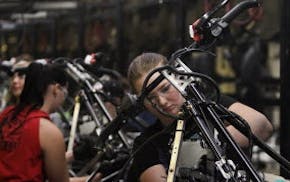Minnesota's moose are getting a big boost in attention and research funding that state officials hope can help curb the rapid die-off of the massive mammals.
On Monday, the state will announce its first, private-public partnership to raise money for research on why an animal synonymous with Minnesota's woods is mysteriously dwindling. The Department of Natural Resources will also unveil a new license plate featuring the moose — the eighth, critical-habitat license plate the state has designed to provide money to conservation efforts statewide.
"We've been trying to draw attention to moose [for years]," said Lou Cornicelli, the DNR's wildlife research program manager. "Moose are a species that aren't found in a lot of states."
The state's latest moves reflect a growing urgency to figure out what's causing the moose population to drop dramatically in recent years and how the trend could be reversed.
New numbers released earlier this year show that population estimates are up over last year — at an estimated 4,350 moose — but due to the variability of the tallies, it's not a statistically significant change, Cornicelli said, and the trend is still downward.
In recent years, researchers have ramped up efforts to better understand the moose population such as by studying calf mortality and conducting aerial surveys. But the research can be costly.
The work is getting a boost from the conservation organization that owns the copyrights and trademarks to the work of artist Les Kouba. Kouba, one of Minnesota's most recognized wildlife artists and a devoted conservationist, died in 1998, but he was among the first wildlife artists of his generation to donate prints and original works to conservation groups to raise money for waterfowl habitat.
Moose are "in the most need right now," said Greg Meyer, a representative of the group Les Kouba Outdoors.
For the first time, the DNR is partnering with the private organization, launching "Call of the Moose Minnesota." Over the next three years, a portion of proceeds from sponsorships or sales of Kouba products will go to fund moose research.
"We're always looking for new [funding] opportunities," Cornicelli said. "This is a good opportunity to focus some funds for moose."
It's too early to estimate how much could be raised for the research, but if it's successful, Meyer said, Kouba's group will help other programs.
"With his vision," Meyer said of Kouba, "he'd be very happy to see what we're doing."
Revamped license plate
Among Kouba's thousands of paintings were several hundred never made public. One of them, depicting an adult moose with large antlers in a wooded area, was selected for the new license plate.
While Kouba won several state and federal duck stamp contests, this is the first time his work is being used on one of the state's critical-habitat license plates, something the Les Kouba Outdoors organization hopes will become the public face for raising awareness about the moose.
Sales of the license plates, available through driver and vehicle services, started Aug. 1.
The money from the license plates, though, won't go to moose research, but instead will go toward the state's Reinvest in Minnesota program, just like the seven other critical-habitat license plates.
Minnesota's iconic moose
Since the license-plate program started in 1995, the plates have generated more than $25 million, helping buy 7,700 acres of critical habitat and funding nongame research.
More than 104,000 vehicles in Minnesota have the special plates, paying $30 a year to the program, which matches every dollar from the plate sales with private donations of cash or land. Of the seven other plates, two depict deer, while the others feature anglers fishing, a chickadee, a pheasant, a loon (the state bird) and the lady's slipper (the state flower).
Adding a moose, the DNR says, will recognize another of the state's most significant animals.
"The moose is an iconic image," said Lori Naumann of the DNR Nongame Wildlife Program. "Anyone who's gone to the Boundary Waters has seen them. They have this impressive size and presence. I think there's a lot of people who really care about them and know their population is declining."
Kelly Smith • 612-673-4141
Twitter: @kellystrib

Why you should donate clothing: It (probably) won't end up at the dump
4 are now charged in inside job armed robbery of Hopkins grocery store that netted $45K

Minnesota added thousands of jobs in March but worker shortage still an issue
Private prison van driver, accused of raping St. Paul woman he was transporting, gets 30 years for similar attacks

![BRIAN PETERSON ï brianp@startribune.com Gunflint Trail, MN ]This bull moose, sprouting the bumps of new antler growth on it's head, grazed in a s](https://arc.stimg.co/startribunemedia/4WNBBYBR2YTLSQRXJNUA4YAWPM.jpg?w=600&h=600&auto=format%2Ccompress&cs=tinysrgb)